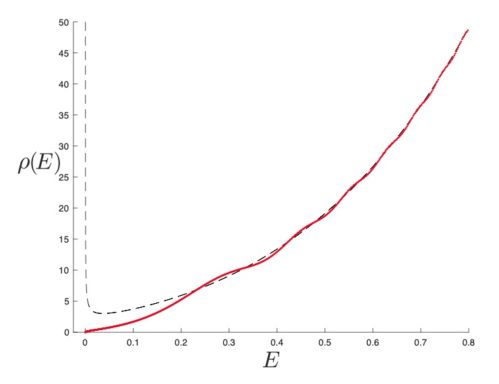Home Lab Kits for Physics Instruction!
My colleague Jack Feinberg is a USC treasure! He’s been building and shipping home physics lab kits to our students. There’s an article about it here. –cvj
My colleague Jack Feinberg is a USC treasure! He’s been building and shipping home physics lab kits to our students. There’s an article about it here. –cvj
Because of a certain movie from earlier this Summer (which I have not yet got around to mentioning here on the blog), I’ve been doing a lot of interviews recently, so sorry in advance for my face showing up in all your media. And I know many will sneer because … Click to continue reading this post
This year’s big annual flagship conference in String theory, Strings 2020, ended two days ago. It was a massive success, and it was held entirely online. There were more than 2000 registered participants from all around the world, with sessions where a large portion of that number were engaged simultaneously! This conference’s attendance more usually ranges at around 300 – 400, as far as I remember, so this was a spectacular change. The success was made possible by -most importantly- the willingness of many people to take part and engage with each other to a degree that was foreign to most participants, combined with smart and tireless effort by the team of organizers in Cape Town, where the conference was originally going to be held physically. There were excellent talks (selected by the programme committee) and many illuminating discussions.
Due to the pandemic, the conference was originally going to be cancelled (or at least postponed to much later in the year), but organizer Jeff Murugan announced at relatively short notice that they were instead going to attempt to do it online on the original dates, and it is wonderful that so many people around the world engaged, instead of just shrinking away into the Covid-19 gloom.
The other major component of the success is what I want to discuss here. It was the use, sometimes in concert, of tools such as Zoom […] Click to continue reading this post
 What’s that now? You want more physics teases? Ok. That dotted line is a (known) JT gravity Schwarzian spectral density. That red line? It’s the fully quantum corrected result! To all orders in topology and beyond. See my paper that appeared today on the arXiv.
What’s that now? You want more physics teases? Ok. That dotted line is a (known) JT gravity Schwarzian spectral density. That red line? It’s the fully quantum corrected result! To all orders in topology and beyond. See my paper that appeared today on the arXiv.
(For experts: The red line is made up of about 2000 points for each of which I know the energy, and the full wave function for an associated problem. Using those I can compute lots of things, to good accuracy. One example is the full non-perturbative spectral form factor, that I showed last post.)
Ok here goes. Been bursting to tell you this for many weeks. Ever wondered what the fully non-perturbative spectral form factor for a JT gravity model looks like? For real? Not in some special limit or simplified model? Here you go.
Paper out on Monday! (I plan on doing a post or two about what this all means.)
Can’t resist some Friday wind-down deep-dive physics humour…
 This Wednesday (10th June), in support of #BlackLivesMatter and the demonstrations taking part worldwide, there will be a day of action in various parts of academia to simply stop doing “business as usual” while the horrors of what is routinely done to black people at all levels of society continue.
This Wednesday (10th June), in support of #BlackLivesMatter and the demonstrations taking part worldwide, there will be a day of action in various parts of academia to simply stop doing “business as usual” while the horrors of what is routinely done to black people at all levels of society continue.
What people choose to do on that day is up to them, but there are suggestions as a number of websites. I encourage you to go there and read what they have to say, and make up your own mind. A good start is the ShutDownStem site, and search under #ShutDownAcademia, #ShutDownSTEM and #Strike4BlackLives on social media for chatter, activity, and more resources. The Particles For Justice group, led by people in or close to my field, have also joined in to lead and encourage, and their site is here, again with lots of suggestions for types of action to get involved in.
Frankly, having seen and heard […] Click to continue reading this post
The desire to have glitch-free online teaching and business meetings at home has driven me to do some infrastructure improvements I should have done years ago: extending the Ethernet backbone of the home network. Connecting the jacks (ethernet connectors) is a tad fiddly (but trivial), but the results are worthwhile! … Click to continue reading this post
[caption id="attachment_19517" align="aligncenter" width="499"] Sharing my live virtual chalkboard while online teaching using Zoom (the cable for the iPad is for power only).[/caption]It is an interesting time for all of us right now, whatever our walk of life. For those of us who make our living by standing up in front of people and talking and/or leading discussion (as is the case for teachers, lecturers, and professors of various sorts), there has been a lot of rapid learning of new techniques and workflows as we scramble to keep doing that while also not gathering in groups in classrooms and seminar rooms. I started thinking about this last week (the week of 2nd March), prompted by colleagues in the physics department here at USC, and then tested it out last Friday (6th) live with students from my general relativity class (22 students). But they were in the room so that we could iron out any issues, and get a feel for what worked best. Since then, I gave an online research seminar to the combined Harvard/MIT/USC theoretical physics groups on Wednesday (cancelling my original trip to fly to the East Coast to give it in person), and that worked pretty well.
Sharing my live virtual chalkboard while online teaching using Zoom (the cable for the iPad is for power only).[/caption]It is an interesting time for all of us right now, whatever our walk of life. For those of us who make our living by standing up in front of people and talking and/or leading discussion (as is the case for teachers, lecturers, and professors of various sorts), there has been a lot of rapid learning of new techniques and workflows as we scramble to keep doing that while also not gathering in groups in classrooms and seminar rooms. I started thinking about this last week (the week of 2nd March), prompted by colleagues in the physics department here at USC, and then tested it out last Friday (6th) live with students from my general relativity class (22 students). But they were in the room so that we could iron out any issues, and get a feel for what worked best. Since then, I gave an online research seminar to the combined Harvard/MIT/USC theoretical physics groups on Wednesday (cancelling my original trip to fly to the East Coast to give it in person), and that worked pretty well.
But the big test was this morning. Giving a two hour lecture to my General Relativity class where we were really not all in the same room, but scattered over the campus and city (and maybe beyond), while being able to maintain a live play-by-play working environment on the board, as opposed to just showing slides. Showing slides (by doing screen-sharing) is great, but for the kind of physics techniques I’m teaching, you need to be able to show how to calculate, and bring the material to life – the old “chalk and talk” that people in other fields tend to frown upon, but which is so essential to learning how to actually *think* and navigate the language of physics, which is in large part the diagrams and equations. This is the big challenge lots of people are worried about with regards going online – how do I do that? (Besides, making a full set of slides for every single lecture you might want to do For the next month or more seems to me like a mammoth task – I’d not want to do that.)
So I’ve arrived at a system that works for me, and I thought I’d share it with those of you who might not yet have found your own solution. Many of the things I will say may well be specific to me and my institution (USC) at some level of detail, but aspects of it will generalize to other situations. Adapt as applies to you.
Do share the link to this page with others if you wish to – I may well update it from time to time with more information.
Here goes:
[…] Click to continue reading this post
How do I prepare my research talks? I usually just sit down with a pencil, some paper and a cup of something warm, and I just draw/map out the story. Each box is a beat of the narrative, and ends up corresponding to one or two slides (if I’m doing … Click to continue reading this post
Updated with lots of new results! For your reading pleasure as 1912.03637 on the arXiv. (And still a swift read at 14 pages.) New results include a fascinating differential equation for spectral densities, and some lovely E=0 results. #physics #blackholes #gravity –cvj
Here’s a striking coincidence. Last Friday I was preparing to deliver a lecture on special relativity to my undergrad General Relativity class with this Hobbity thought experiment (that helps one discover Lorentz-Fitzgerald contraction), when I heard that Christopher Tolkien (the boy the Hobbit was originally written for) had died. (RIP. … Click to continue reading this post
(A somewhat more technical post follows.)
Continuing from part I: Well, I set the scene there, and so after that, a number of different ideas come together nicely. Let me list them:
[caption id="attachment_19442" align="alignright" width="250"] What “nearly” AdS_2 looks like via JT gravity. The boundary wiggles, but has fixed length 1/T.[/caption]
What “nearly” AdS_2 looks like via JT gravity. The boundary wiggles, but has fixed length 1/T.[/caption]
The basic Schwarzian computation mentioned above therefore gives the leading piece of the partition function, i.e., $latex g=0$, and so that’s why I put the subscript 0 on it at the outset. A big question then is what is the result for JT gravity computed on all those other topologies?!
(A somewhat more technical post follows.) Well, I think I promised to say a bit more about what I’ve been up to in that work that resulted in the paper I talked about in an earlier post. The title of my paper, “Non-perturbative JT gravity” has JT (Jackiw-Teitelbiom) gravity in … Click to continue reading this post
Oh, this? I’m very pleased with it. I’ll tell you more about what it is at a later point, but this is mostly for my own entertainment. It’s a sort of big brother to the spectral curve shown in the previous post. I’d been thinking about how to get this … Click to continue reading this post